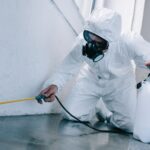We’ve all heard the horror stories of burst pipes seemingly out of the blue. Many older homes have pipes that are up to 100 years old and have made tons of repairs since then. If you have a property that’s nearing its twentieth birthday, you may be wary.
Still, pipe leaks aren’t always signs of impending disaster. Older pipes may be showing signs of wear and tear but can last a few years longer if you watch out for warning signs. However, you must find and fix even the smallest leaks. This is because even a slow drip can accumulate around your foundation and leave you needing slab leak repair from an experienced plumber.
You don’t need to think about plumbing disasters. Here’s what to do if a pipe is leaking.
Locate the Source of the Leak
If you have leaky pipes, it is important to locate the source of the leak first. This can be done by listening for a dripping sound near the pipe, cleaning water from the floor to assess the location of the leak better, or shutting off the water supply to the entire building and turning on all the plumbing fixtures to see which one is dripping and pinpoint the source of the leak.
Shut Off the Water Supply
Act quickly and shut off the main water supply to the home as soon as possible. This process can be done by going to the main water shutoff valve, usually in the basement or outside the house. Once the water is shut off, it is important to call a plumber to repair the leak and replace the broken part.
You can also tap the leaking pipe to see how much water is coming out, which can help the plumber diagnose the problem.
Identify the Type of Pipe
Depending on the type of pipe, the methods used to fix the leak may vary. For example, if the pipe is PVC, you should look for a crack or break. You should use a clamp to stop the water and repair the crack if the pipe is metal.
In both cases, the best option is to seal the pipe with either epoxy or plumber’s tape. Once you have identified the type of pipe and sealed it, check it again with pressure to make sure it is completely sealed. If there is still a leak, contact a licensed plumber to inspect and repair the pipe.
Use Sealants and Adhesives to Fix Minor Leaks
If the damage is minimal, it is possible to use sealants and adhesives to fix the leak. Start by identifying the leaking spot and then clean it with a dry cloth to remove debris or dust.
Apply an appropriate sealant or adhesive labeled “for plumbing” to the leaking spot and allow it to set according to the instructions. Once dry, fill the area with water and inspect the pipe to ensure no further leaks before turning the water supply back on.
It is important to remember that this solution is only suitable for minor plumbing issues. If there is more extensive damage, it is best to consult a professional plumber.
What to Do When a Pipe is Leaking
When a pipe is leaking, it’s important to turn off the main water supply to the pipe and call a professional plumber to fix the leak. As soon as the leak has been identified and the necessary repairs have been made, you can turn the water back on for your home or business. Don’t wait – call a plumber now to prevent further damage or costly repairs.
Do you want to learn more about your home and what you can do to improve your property? Check out our blog to learn some new tips and tricks today.




